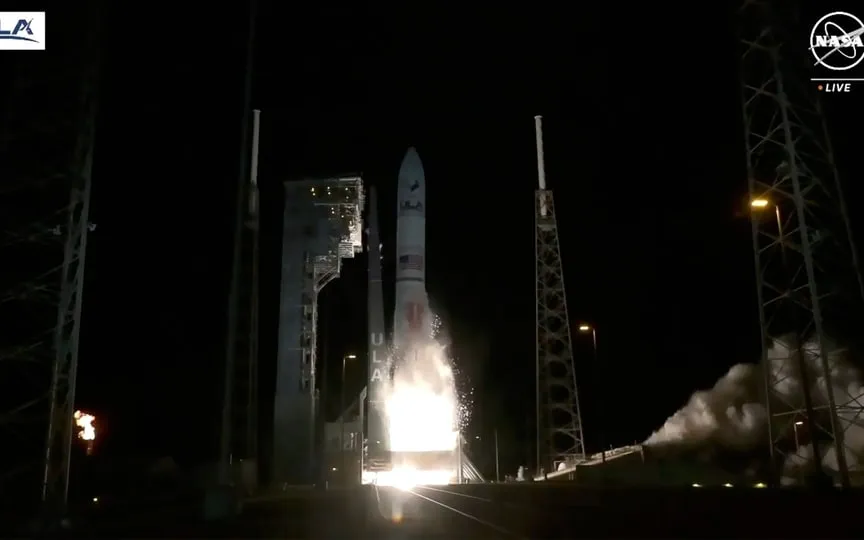Private US lunar lander faces failure after ‘critical fuel loss’, dealing a setback to NASA
NASA, the US space agency, experienced a significant setback as a pioneering private mission to land on the Moon encountered an almost certain failure on Monday. The spacecraft suffered a severe depletion of fuel, dealing a major blow to America’s aspirations of deploying its initial robotic presence on the lunar surface in fifty years.
Attached to United Launch Alliance’s new Vulcan rocket making its maiden flight, Astrobotic’s Peregrine Lunar Lander blasted off overnight from the Cape Canaveral Space Station in Florida and then successfully separated from its launch vehicle.
A few hours later, Astrobotic began reporting technical problems, beginning with Peregrine’s upper-mounted solar array being unable to point toward the Sun and keep its onboard battery charged due to a malfunction in its propulsion system.
Although engineers “improvised” a way to tilt the spacecraft in the right direction and keep its power running, the company then posted on X that the same propulsion malfunction appeared to be the cause of the “critical loss of propellant.”
“We are in the process of evaluating what alternative mission profiles may be feasible at this time,” Astrobotic said, acknowledging the obvious that Peregrine would not achieve a controlled touchdown on the Moon as planned.
They also released an image taken from a mounted camera that showed extensive damage to the outer layer of the spacecraft, calling it the first “visual clue” to support their theory of a propulsion system anomaly, without elaborating on its nature.
Peregrine was supposed to reach the Moon and maintain its orbit for several weeks before landing in a mid-latitude region called Sinus Viscositatis on February 23.
A soft landing on Earth’s closest celestial neighbor has so far been achieved by only a handful of national space agencies: the Soviet Union was the first, in 1966, followed by the United States, which remains the only country to put humans on the Moon.
China has managed to land three times in the last decade, while India was the last to achieve the feat last year.
– Pivot to private –
The US is turning to the commercial sector to stimulate the wider lunar economy and deliver its hardware at a fraction of the cost of the Commercial Lunar Payload Services (CLPS) program – but Astrobotic’s apparent failure could lead to criticism of the new strategy.
However, NASA Administrator Bill Nelson doubled down, praising the success of ULA’s Vulcan rocket on its maiden voyage, which maintained the company’s 100 percent success rate for more than 150 launches.
“Spaceflight is a bold adventure and @astrobotic is making progress on CLPS deliveries and Artemis. @NASA continues to expand our reach in space with our commercial partners,” Nelson said at X.
NASA paid Astrobotic more than $100 million, while another contractor, Houston-based Intuitive Machines, plans to launch in February and land near the moon’s south pole.
The space agency hopes to use such missions to study the lunar environment, paving the way for its Artemis program, which will return astronauts to the moon later this decade in preparation for future missions to Mars.
– Failure occurs –
A controlled approach to the Moon is challenging, and about half of all attempts fail.
With no atmosphere to allow the use of parachutes, the spacecraft must navigate treacherous terrain using only thrusters to slow the descent.
Private missions by Israel and Japan, as well as a recent attempt by the Russian space agency, have all ended in failure – although the Japanese space agency is aiming for mid-January after launching its SLIM lander last September.
In addition to the science instruments it carries for NASA, Peregrine carries colorful cargo paid for by private customers, such as physical Bitcoin, as well as cremation remains and DNA, including those of Star Trek creator Gene Roddenberry, legendary sci-fi author Arthur. C. Clarke and the dog.
The Navajo Nation, America’s largest indigenous tribe, had opposed sending human remains to the moon, calling it a desecration of sacred space. Although they were granted a final meeting with White House and NASA officials, their concerns were ultimately ignored.
Also read these top stories today:
Sorry for the online shopping!
Buying only from online stores was convenient, but now we have to deal with sending unwanted products back to these retailers.
Dive here.
If you enjoyed reading this article, please share it with your friends and family.
The iPhone 15 launched uncharacteristically slowly in China.
The rest of the market share grew, with Huawei growing the fastest behind the Huawei Mate 60. Know why this happened here.
Was it interesting? Go ahead and share it with everyone you know.
Nvidia just released some big benefits for PC buyers!
Nvidia announced new chips that help gamers, designers and other computer users make better use of artificial intelligence in their computers. Nvidia says it’s now leading the AI PC race after announcing new chips! Know what has been revealed here.
If you enjoyed reading this article, please share it with your friends and family.




